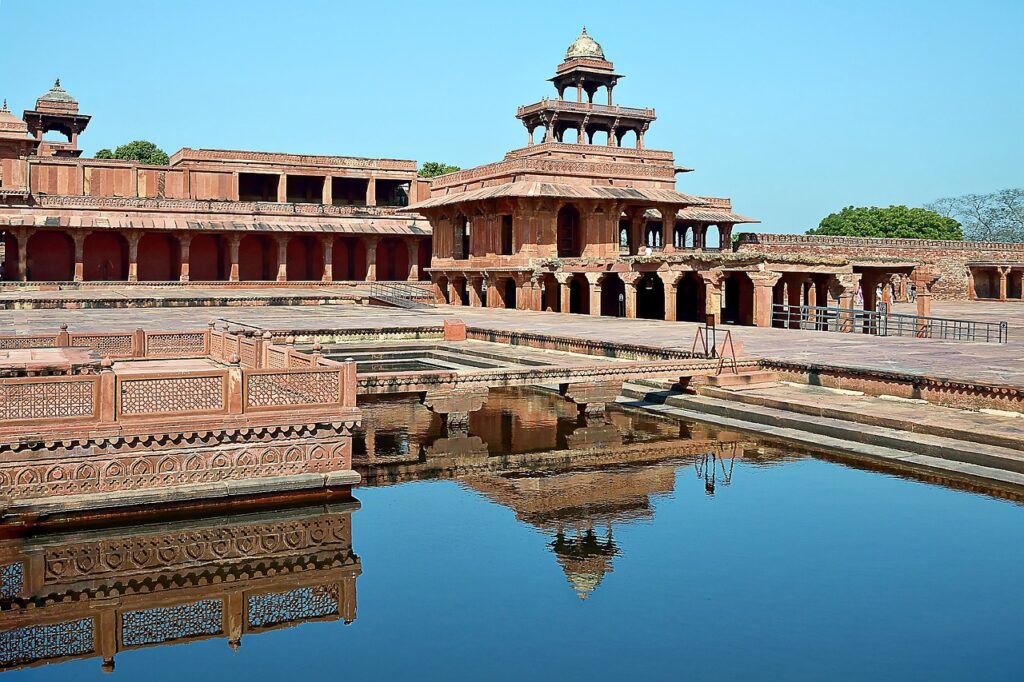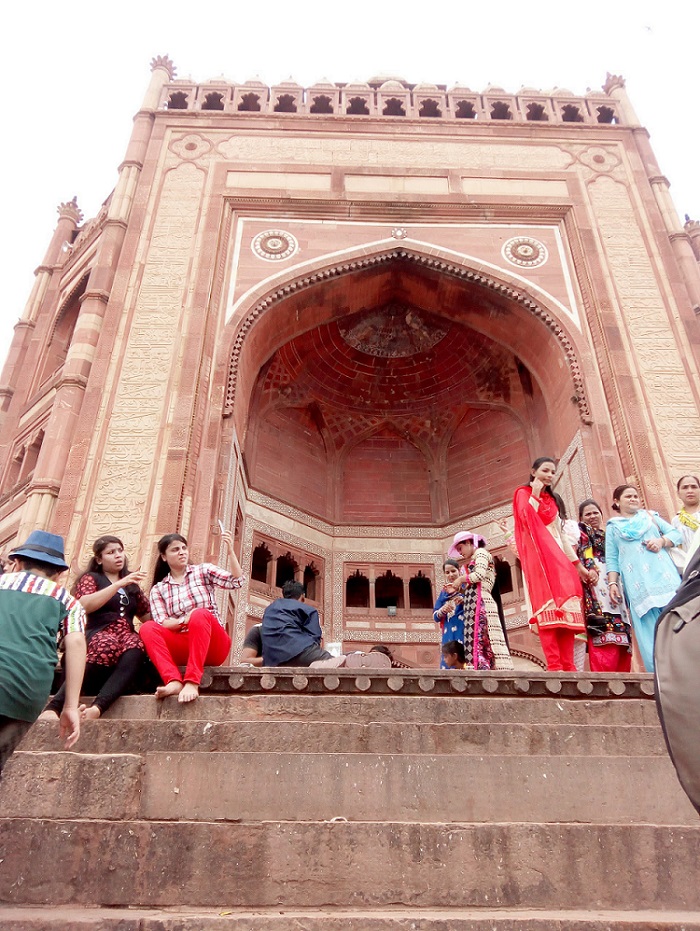Fatehpur sikri the World heritage site of India, as we have discussed before I would like to put all the information of the world heritage monuments of India, that has great cultural and historical values. That beautifully presents a great understanding of building art and architecture. Fatehpur shikri the world heritage site of India is one among the 40 world heritage sites of India.
Fatehpur shikri is a walled city surrounded with high thick ramparts, now very few remained on its historical planned lineage. This was the capital city after Agra Fort built in 1569 by Emperor Akbar. He shifted his capital here and stayed for only 13 years, as there was scarcity of water.
A small lake and water pond natural and artificially made by Akbar, could not be enough to keep the demand of their people in this new city. Fathepur Shikri is the combination of two massive complex of buildings. One near Jodhabai gate on the west is a mosque and other is the fort of Shikri on the east side built with red sandstone and white marble.

How to reach the Fort complex
How to reach fatehpur shikri the world heritage site of India could be a common question among local as well as the foreign visitors, well here is the answer of your worry. It is located 38 km from the main city of Agra on the national highway 21 that connects the Agra to Jaipur of Rajasthan. One can have view of the shikri from this highway as well. To fully see and explore this old ruined city of Akbar one can take a five minute car drive from the highway.
This artery route takes you to Agra gate of this walled city, crossing through the local market on the road side. Mostly local people sell here fruits, water, locally made nankhatai biscuits that appears to be solid and stuffed but it is sweet and hollow inside though tasty, peanuts and many more. There are few small restaurants and tea stalls as well on this market that is always lively with the tourists, vehicles and local people all through the daytime.
As you go near the Agra gate you will see a big lofty entrance gate built of red sandstone wide enough to pass a bus at a time. It was for the purpose of royal elephants and horses while entering from Agra city. This is the main entrance for all tourists and local people to enter Fatehpur shikri the world heritage site of India.
Pass through the Agra gate
Moving ahead one can encounter another side road leading to Diwan-e-Aam through high ruin structures on their right. But you will be taken to the main parking lot of this heritage. Here from the parking there is a pathway near the local artifacts market leading to the bus parking and Gulistan complex. A complex of offices and tourist facilities, resort and restaurant.
Take a bus for the Fort from here, which after filled take less than 5 minutes to reach you to the ticket window of the monument. There are two ways of the buses, one for Diwan-e-Aam and another for Jodha Bai gate.
Diwan-e-Aam or public audience hall meant to give orders to the ministers to resolve the public issues before the general people of the city by the Emperor. While moving to Diwan-e-Aam near the Agra Gate one can see many ruin structure on either sides of the road. These ruin structures were the shopping arcade and all type of trades were taking place here during the Mughal reign.
You will pass through the arch gates on this road and reach near the Taksal the factory building on right side. This massive factory used to produce all types of arm and ammunition during that time. On your left a new building developed for the musuem which houses many objects related to the Mughal empire.
Public facilities are available here like water and restrooms near the entrance gate of Diwan-e-Aam. Take your ticket from the counter by cash or online, and enter the fort complex. Entrance Tickets for the Foreign nationals is 600 rs by cash and 550 if purchased through online. Prices are subject to change according A.S.I. fare policy on time and occasion. Children below 15years are exempted for tickets for both indian and Foreign visitors.
Enter to the Fort from Diwan-e-Aam
As you enter from the gate a green rectangular garden surrounded with pathways showed up. The pillered corridor of red sand stone sourround this area. On The west side corridor there is a lattice disigned chamber facing to the east is the place where throne of Emperor lied. The Emperor appeared in this chamber from the backside and give their command after listening the issues of their subject almost everyday.
On the right side small garden, one can find a small but heavy stone with a whole in it. It is to tie the Elephant for the accused of severe crimes. Moving ahead the guards will check your tickets and let you in the Fort. The fort has many beautiful and architecturally rich buildings which made this fort quite attractive.
The Main complex of the Fort
The main complex of this fort and the Jama Mosque with the Buland Darwaza constitute the city of fatehpur shikri the world heritage site of India. Here we will discuss the Fort complex and later on the Jama Mosque and the Gateway. The fort complex is divided on two sections. One with diwan-e-Aam and other buildings as follows. As one enter from this side the first structure is a four pillared pavilion probably for the guards. The other impressive building in front of it is the Diwan-e-Khas or private meeting palace. This building appear to be very simple and has double storey from outside. With four gates and four small canopy on its roof. While center has no dome on it, is a single storey building.
Enter the hall you will find a completely different architecture of 16th century in this square room. There is a stone pillar in the center with four shoulder stone beam connecting the corners. The pillar is beautifully carved with many different symbolic designs of different religions of the world and India. It holds a round terrace on its top where the Emperor Akbar used to sit and discuss the theology of different religion from its religious teachers.
As he started to build a new religion called Din-e-Ilahi which comprises all the good points from all religion for their subjects, but it could not last long. The camber has four corner and heavy stone carving on the corners and the center make this hall unique in its character. There is no direct staircases to go up, but two inside the walls of this chamber closed for the public. One For the Emperor and one for their guests and scholars.
The treasury house and other palaces of the Fort
In front of the Diwan-e-Khas on the west side one can see a three rooms building, surrounded with a pillared gallery. This building is only for the purpose of accumulating the treasury of the Empire. This place is situated on a high rocky place from the ground. And so one can have a glimpse of the nearby village and national highway 21 which goes to Rajasthan from here.
Next to the building on its south is a pillared structure used to be the madarsa or school for the royal princesses. Also used to watch the musical dance or concerts from its top can be climbed by the flight of steps. On its west the five storeys building called panch mahal is an open fabulous pillared pavilion. It has more than 170 stone pillar that hold the whole building and their architecture is different in each storey. This palace is used to be the resting place of Emperor with their consorts.
Moving ahead on the southeast from this building there is an artificial pond with a central square stone platform for the musician. The Emperor Akbar was fond of many different things in his lifetime. He was fond of arts, architecture, books , knowledge, music, hunting,warfare as well as administration and perfection in his work. The famous musician Tansen was his musician and palyed many songs and music for the Emperor. So this platform in the pond was only for the Tansen. Who while singing, it is said that floating mud lamps with oil were lit itself during the song of Tansen.
Other Interesting Palaces to See
A double storey building standing on the pillars for courtiers and Royal Family, is just south of the pond.The sleeping room of Emperor Akbar is just behind this platform. It has a high platform of red sandstone standing on pillars. There is no other thing in this room except three steps that faces on the opposite side of the king-size bed. The direction of the steps is toward west side while the bed is on the east of the steps. Probably it suggests that the way to reach his bed is little long and creative. As the door to enter the stone bed is from outside of the wall. The door to bed is closed for public.
There is an egg shaped big water tank, built of red sandstone near the dining hall on the south corner of the pond. This room is empty but it has few traces of flower paintings of white and red flower. This was Emperor private dining hall. The water tank is still here but only few portion of its is still survived.
Here a beautiful room on the north corner of the pond connected with a half survived corridor of red sandstone. Which is delicately and deliberately carved with many designs of flora and fauna is really eye catching. The upper walls of the room has plants, leaves and fruits of pomegranate and grapes. While the inside of the room has Lion, parrots, peacoks and banana tree carvings. The roof of this room is intricatly carved with many designs. This was the room attached with the pond for the Turkish wife of Emperor Akbar is still ornamentally rich in its designs.
The other section of the fort lets walk on the west gate.
As you cross the gate we have a beautiful palace of three rooms and surrounding cooridors. This palace is called the Mariyam-uj-zamani palace. It has a colorful room for make-up and decoration of the empress. The other rooms are small camparing to the rectangular room with north facing. It has many paintings on its walls. Few still survived and one can have a glimpse of the empress on its inner south wall. There are many miniature paintings of human, animal, forts and army on the exterior of the palace corridor but all are not so clearly visible as it should be.
On the back side of this palace there is a beautiful garden and few other structures that is now being used as the service area for the visitors. On the west side of the Palace one can find a pool tank with stairs. It was for the ladies to take bath during summer. It is now open from three sides but evidently enclosed by the walls which got collapsed later.
The other buildings and remains on this line
Another building here is a pillared pavilion which holds a bridge on its top. The other side of the over bridge has some ruined structures with room and staircases. That were for the purpose of royal ladies to come to the bathing chamber without getting noticed by anyone. Moving ahead there are a water tank now in ruin condition, was probably to supply the hot or cool water for the ladies bath chamber.
Another attractive building here with four rooms is beautifully carved with many designs on its exterior and interior walls was for one of the minister of Akbar’s cabinate. It was priorly used by a mughal prince but later used by the Birbal. Known for his quick wit and remarks in the court of Akbar. He was also very close to Emperor Akbar because of his wisdom.
A long corridor here with many stone for the horses or camels. The general army meetings were also held by the Chief of army at this place.
Now take a back step and return to Mariyam-uj-zamani Palace to see theEmpress Jodhabai kitchen and Palace. The kitchen here is only for the Jodhabai who originally belongs to a Rajput faimily of Amer. She got married with Emperor Akbar to strenghten the Mughal and Rajput alliance. She was vegitarian and therefore a kitchen for her built near her palace.
The Massive Jodhabai Mahal
The Jodhabai Mahal or palace of Jodhabai is a massive building in this fort of Fatehpur shikri. It has many rooms and chambers for other wives or ladies of harem here. There is a big square courtyard with a central flower pot. On the west of the palace a beautiful open hall is for the purpose of prayer built for Jodhabai. This is the temple where jodhabai worship her Deity according to Hindu religion.
The north side of the palace with blue tile roof known as summer Palace. While on the opposite side the Palace is called as winter palace. The summer palace is attached with the over bridge, on its back side and also allow the air to cool the building. While the winter palace has almost no any window or ventilator to keep the room warm. The staircases are closed for the public and rooms are dark inside. So it is advised not to go inside or stay for long.
As it is 16th century old building and built completely of red sand stone houses many parrots, pegions and also bat in the dark areas. This sturdy building shows the intention of the Emperor who focuses all the comfort for his wife Jodhabai. It is because Jodhabai gave birth the child Salim who later became the emperor of Hindostan.
The Great Gateway and the Jama Mosque

During this time when he was engaged in a conflict with rebellion in the Gujarat province, he got the news of his newly born child and also got victorious in Gujarat. He built a massive gateway on the south of the Jama Mosque. The height of this lofty arch gateway is about 54 meters and this is world highest gateway. In local language it is called as Buland Darwaza the great gateway with three sides flights of steps. It got listed in the world heritage site in 1986 by UNESCO. This way the fort and mosque area with this highest gateway, it is recognized as fatehpur shikri the world heritage site of India.
The Jama mosque is also very attractive from inside and situated on a high platform of this city. Built to please the sufi saint Salim chishti who blessed Emperor Akbar that soon he will have three sons. This prophecy became true and Jodhabai gave three sons to Akbar who survived. Akbar had many wives and he became father of a daughter but the male infant could not survived for long.
This situation made Akbar walk bare foot to the cave of Salim Chishti. Who was a sufi saint living lonely in this area. Seeing the true wish and dedication of Emperor Akbar. He made him assured that the Allmighty will definitely do well for his desire. And he prayed for the Emperor to Allah the Allmighty, to be merciful and graceful on his wish to have a healthy child. After the death of Salim Chishti, Akbar made a tomb of white marble inside the mosque. People who do not have child still in the modern times, visit the tomb of Sufi saint for their wish to be fulfilled by the Allmighty.
Return to the parking lot and catch your car
So here we have almost seen all the part of the Fatehpur shikri. After the Jama Mosque and Buland Darwaza visit, and the heritage monument of fatehpur. It is now time to take a bus back to the parking lot. Here the journey ends and another journey for other monuments of Agra or Jaipur starts.
